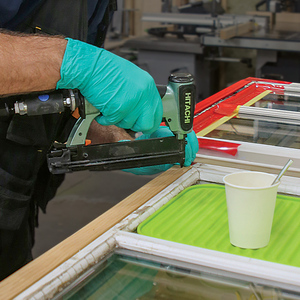I need to add a new washer dryer hook up in an unfinished basement. The wiring and supply lines seem straight forward I am stuck at the DWV. There is a 2″ waste stack down there that serves the Kitchen sink and dish washer. The 4″ waste stack is not in an accessible position to use. Can I drain into the 2″ waste? I want to use a P-trap and pipe stand and go into the stack above the clean out. But what about the vent? Do I need to use an air admittance valve? And were do I put it?
New to online advice, Thanks whands



















Replies
I would wait for a real plumber to weigh in but if the sink is properly vented all you should have to do is cut into the 2" as low as you can and put in a p-trap, standpipe to what is required, usually code and washer manufacturer specifies a minimum.
The stand pipe is sort of it's own vent as long as you do not seal off the drainhose into the standpipe. If the upstairs part is not properly vented you could siphon the upper traps. Pretty unlikely but possible.
Food for thought until one of the plumbers chimes in.
Bob
I'm not a plumber either and while I agree on the venting, something seems wrong with this as far as cutting in. Seems the water draining from the sink would up and out the stand pipe.Definitely VERY true on the ehight for the washer waste line. Too high or too low and the washer will not work right.
Welcome to the Taunton University of Knowledge FHB Campus at Breaktime. where ... Excellence is its own reward!
Venting goes on the SEWER side of the trap.I have never seen a "waster receptacle" of any kind that was not automatically "vented" on the oposite side of the trap.Ie, kitchen sinks, vanity, floor drains, toilets, all have the side of the trap oposite to the sewer "vented" to the house.But the still need venting on the sewer side of the trap.In this case the potential problem would be that slug of water from the kitchen sinks would be enough to fill the pipe and after it went past the washer trap to cause a vacum to pull it dry.Now in some cases wet venting can be used. But I don't know if this is one of them or not.And the two major codes (UPC and IPC/IRC) have different ideas on venting.My though is that the venting to sink would be enough to eliminate this problem, but I really don't know..
.
A-holes. Hey every group has to have one. And I have been elected to be the one. I should make that my tagline.
Yeah, I meant to say air gap/vac break for hose into standpipe. I guess a big slug from sink could suck washer trap but generally the sink and dw are coming through a 1 1/2 pipe into the 2" and he would have a 2" trap on the washer. Believe you would have to have a series of issues for that to happen. One being the lack of proper venting above sink as mentioned.
He could put a t and another stand pipe in the lateral between the trap and stack and put in an AIV but seriously doubt if it would be needed. I would make my lateral long enough to do that if it did become a problem.
I am not clear on where you can use a wet vent either.
Bob
UPC 2000 allows wet venting of fixtures on the same floor level only. But the OP may be in an IPC/IRC state, in which case my input may count for bupkus.
My understanding is this: vertical wet venting is allowed if the stack is one size larger than would otherwise be required. So, if it's just a kitchen upstairs and 2" is all that's required for that, then the stack in the basement would have to be 3" in order for the washer trap to be otherwise unvented.
Now, I could be wrong about this. The fact that the traps are on different floors may have some impact on what the code allows. Never had to decipher that part of the code.
You are correct in that the trap does require venting on the sewer side and that the loose fit of the washer drain hose into the standpipe is irrelevant.
What I would do is use a 2" combo fitting near the floor for the standpipe, and then another above it to install an AAV well above the standpipe and washer, in an accessible location. I'm almost 100% that our picky inspector here would OK that.
IF I understand it correctly a combo is only used when going from vertical to horizonatal.But is is going from the trap arm on the washer (horizontal) to veritical and that requires a sani-tee.http://www.codecheck.com/pg13_14plumbing.html#drainsNote the references in [] is IRC, those in {} are UPC.
.
.
A-holes. Hey every group has to have one. And I have been elected to be the one. I should make that my tagline.
You are correct. For reasons I don't understand the fitting in the stack would have to be a tee if the trap is at the same level.
There reason is that with the combo it can syphon out the trap.It has to do with the height of where the water discharges from the fitting in relation to the level of the water in the trap.I understand the concept, but not enough to really tell where you have a problem and where you don't..
.
A-holes. Hey every group has to have one. And I have been elected to be the one. I should make that my tagline.
With the combo the waste water would probably form more of a continuous stream as it flows down into the stack, and possibly siphon the trap as you say. With a san tee the flow would break up into falling droplets as it goes to vertical, with less chance of siphoning.
No doubt it does happen. I bet some lab guys somewhere made some glass fittings so they could study how the streams work.
washing machine dont need vents due to loose fitting drain lines fom machine
"washing machine dont need vents due to loose fitting drain lines fom machine."
Not true. A washing machine must drain into a trap and all traps need to be vented. The issue is not at the top end of the drain, but at the exit end of the trap where a vacuum can result, emptying the trap, if it is not properly vented.
I'm not sure I understand the OP's description of what he is trying to do, but it sounds like his proposal will result in a wet vent and these are treated differently in the code. I never understood the code provisions for them so I avoid them.
Mike HennessyPittsburgh, PA
i agree it has to be vented to work properly. mine is connected to my kit sink with only the sink vented and ocasionaly it sucks the traps dry emitting sewer gas!!
You'll be OK, no worries, just tap in with a 2"x2"x2" wye combo pretty down low,short nipple, p-trap. riser up to about 30" to 34". That 2" stack is probaly vented or is the vent.You would have been sucking the upstairs kitchen p-trap dry if it was"t. What you'll end up with, if it isn"t already, is a wet stack. which is fine on a 2" line. The worst that could happen is if you try to drain the kitchen sink with a clog below the washer hook up. Even then a separate vent wouldn't have helped you and wouldn't be worth the time and money to re-vent up above the kitchen sink drain.
I can tell you from my own experience that you should vent properly and in this case I would use an AAV since it is not practical to tie in above the kitchen sink. I hooked up my washing machine temporarily (during construction) without a vent and it overflowed because of slow drainage. You could do ten loads of laundry and it would be fine, then suddenly stop draining. Pull the drain hose from the standpipe and the water would gurggle down, then drain fine again until the next random event. Installed an AAV and it never happen again for almost a year until the washer was moved. Learned my lesson - luckily there was no water damage due to the construction at the time.
Jerry
Thanks for the info about the aav. I will put one in. I was going to put it down stream of the washer stack and trap and before it enters the verticle stack coming from the kitchen above. I was going to make it higher than the washing machine but didn't know if it has to be higher?
Definitely higher.
if it were me i would tap into the 2 inch and put a mop sink in vented and have the washer drain into sink